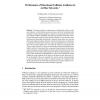Free Online Productivity Tools
i2Speak
i2Symbol
i2OCR
iTex2Img
iWeb2Print
iWeb2Shot
i2Type
iPdf2Split
iPdf2Merge
i2Bopomofo
i2Arabic
i2Style
i2Image
i2PDF
iLatex2Rtf
Sci2ools
117
Voted
NETWORKING
2004
2004
Performance of Directional Collision Avoidance in Ad Hoc Networks
Abstract. This paper analyzes the performance of directional collision avoidance schemes, in which antenna systems are used to direct the transmission and reception of control and data packets in channel access protocols based on fourway collision avoidance handshake. We present an analytical model that considers both directional reception and the possible difference in gain between omnidirectional and directional transmissions. Analytical results show that, when the directional collision avoidance scheme in which all transmissions are directional is augmented with directional receiving, one-hop throughput does not decrease due to the increased spatial reuse, even when the number of competing nodes within a region increases as long as the directional transmission/reception beamwidth is narrow. It is also shown that, as expected, the performance of directional collision avoidance schemes degrades when directional transmissions have much higher gain than omni-directional transmissions. H...
Collision Avoidance Schemes | Directional Collision Avoidance | Directional Transmissions | NETWORKING 2004 | NETWORKING 2007 |
Related Content
| Added | 31 Oct 2010 |
| Updated | 31 Oct 2010 |
| Type | Conference |
| Year | 2004 |
| Where | NETWORKING |
| Authors | Yu Wang 0007, J. J. Garcia-Luna-Aceves |
Comments (0)

